Analysis of Pressure Effect on Three-Dimensional Flame Surface Density Estimation
Abstract
1. Introduction
2. Experimental Methodology
Experimental Setup and Measurements
3. Flame Surface Density
3.1. Definition
3.2. Notations and 3D/2D Exact Relation
4. Modeling and Approximations of
4.1. DNS Results and the Measurements
4.2. Isotropic Normal Vector
4.3. Analysis of the Fluctuations of Normal Vectors
5. Results and Discussion
5.1. OH-PLIF Image and Processing Method
5.2. Three-Dimensional Evaluation at Different Pressures
5.3. Three-Dimensional Analysis
5.4. Global Fuel Consumption Rate Tests
6. Conclusions
Author Contributions
Funding
Institutional Review Board Statement
Informed Consent Statement
Data Availability Statement
Acknowledgments
Conflicts of Interest
Sample Availability
Abbreviations
| PSD | Flame Surface Density |
| PLIF | Planar Laser Induced Florescence |
Appendix A
References
- Peters, N. Laminar flamelet concepts in turbulent combustion. In Proceedings of the Symposium on Combustion, Seattle, WA, USA, 14–19 August 1988; Volume 21, pp. 1231–1250. [Google Scholar]
- Damköhler, G. Der einfluss der turbulenz auf die flammengeschwindigkeit in gasgemischen. Z. Elektrochem. Angew. Phys. Chem. 1940, 46, 601–626. [Google Scholar]
- Driscoll, J.F. Turbulent premixed combustion: Flamelet structure and its effect on turbulent burning velocities. Prog. Energy Combust. Sci. 2008, 34, 91–134. [Google Scholar] [CrossRef]
- Shepherd, I. Flame surface density and burning rate in premixed turbulent flames. In Proceedings of the Symposium (International) on Combustion, Houston, TX, USA, 13–17 October 1996; Volume 26, pp. 373–379. [Google Scholar]
- Veynante, D.; Vervisch, L. Turbulent combustion modeling. Prog. Energy Combust. Sci. 2002, 28, 193–266. [Google Scholar] [CrossRef]
- Lee, G.G.; Huh, K.Y.; Kobayashi, H. Measurement and analysis of flame surface density for turbulent premixed combustion on a nozzle-type burner. Combust. Flame 2000, 122, 43–57. [Google Scholar] [CrossRef]
- Kobayashi, H.; Otawara, Y.; Wang, J.; Matsuno, F.; Ogami, Y.; Okuyama, M.; Kudo, T.; Kadowaki, S. Turbulent premixed flame characteristics of a CO/H2/O2 mixture highly diluted with CO2 in a high-pressure environment. Proc. Combust. Inst. 2013, 34, 1437–1445. [Google Scholar] [CrossRef]
- Zhang, M.; Wang, J.; Wu, J.; Wei, Z.; Huang, Z.; Kobayashi, H. Flame front structure of turbulent premixed flames of syngas oxyfuel mixtures. Int. J. Hydrogen Energy 2014, 39, 5176–5185. [Google Scholar] [CrossRef]
- Halter, F.; Chauveau, C.; Gkalp, I. Characterization of the effects of hydrogen addition in premixed methane/air flames. Int. J. Hydrogen Energy 2007, 32, 2585–2592. [Google Scholar] [CrossRef]
- Guo, H.; Tayebi, B.; Galizzi, C.; Escudi, D. Burning rates and surface characteristics of hydrogen-enriched turbulent lean premixed methane air flames. Int. J. Hydrogen Energy 2010, 35, 11342–11348. [Google Scholar] [CrossRef]
- Hult, J.; Omrane, A.; Nygren, J.; Kaminski, C.; Axelsson, B.; Collin, R.; Bengtsson, P.-E.; Aldén, M. Quantitative three-dimensional imaging of soot volume fraction in turbulent non-premixed flames. Exp. Fluids 2002, 33, 265–269. [Google Scholar] [CrossRef]
- Karpetis, A.N.; Barlow, R.S. Measurements of flame orientation and scalar dissipation in turbulent partially premixed methane flames. Proc. Combust. Inst. 2005, 30, 665–672. [Google Scholar] [CrossRef]
- Veynante, D.; Lodato, G.; Domingo, P.; Vervisch, L.; Hawkes, E.R. Estimation of three-dimensional flame surface densities from planar images in turbulent premixed combustion. Exp. Fluids 2010, 49, 267–278. [Google Scholar] [CrossRef]
- Halter, F.; Chauveau, C.; Gkalp, I.; Veynante, D. Analysis of flame surface density measurements in turbulent premixed combustion. Combust. Flame 2009, 156, 657–664. [Google Scholar] [CrossRef]
- Zhang, M.; Wang, J.; Jin, W.; Huang, Z.; Kobayashi, H.; Ma, L. Estimation of 3D flame surface density and global fuel consumption rate from 2D PLIF images of turbulent premixed flame. Combust. Flame 2015, 162, 2087–2097. [Google Scholar] [CrossRef]
- Deschamps, B.; Smallwood, G.; Prieur, J.; Snelling, D.; Gülder, Ö. Surface density measurements of turbulent premixed flames in a spark-ignition engine and a bunsen-type burner using planar laser-induced fluorescence. In Proceedings of the Symposium (International) on Combustion, Houston, TX, USA, 13–17 October 1996; Volume 26, pp. 427–435. [Google Scholar]
- Hawkes, E.R.; Sankaran, R.; Chen, J.H. Estimates of the three-dimensional flame surface density and every term in its transport equation from two-dimensional measurements. Proc. Combust. Inst. 2011, 33, 1447–1454. [Google Scholar] [CrossRef]
- Kobayashi, H. Experimental study of high-pressure turbulent premixed flames. Exp. Therm. Fluid Sci. 2002, 26, 375–387. [Google Scholar] [CrossRef]
- Wang, J.; Zhang, M.; Huang, Z.; Kudo, T.; Kobayashi, H. Measurement of the instantaneous flame front structure of syngas turbulent premixed flames at high pressure. Combust. Flame 2013, 160, 2434–2441. [Google Scholar] [CrossRef]
- Pope, S.B. The evolution of surfaces in turbulence. Int. J. Eng. Sci. 1988, 26, 445–469. [Google Scholar] [CrossRef]
- Boger, M.; Veynante, D.; Boughanem, H.; Trouvé, A. Direct numerical simulation analysis of flame surface density concept for large eddy simulation of turbulent premixed combustion. In Proceedings of the Symposium (International) on Combustion, Boulder, CO, USA, 2–7 August 1998; Volume 27, pp. 917–925. [Google Scholar]
- Wang, H.; Hawkes, E.R.; Chen, J.H. Turbulence-flame interactions in DNS of a laboratory high Karlovitz premixed turbulent jet flame. Phys. Fluids 2016, 28, 91–134. [Google Scholar] [CrossRef]
- Wang, H.; Hawkes, E.R.; Chen, J.H.; Bo, Z.; Li, Z.; Marcus, A. Direct numerical simulations of a high karlovitz number laboratory premixed jet flame—An analysis of flame stretch and flame thickening. J. Fluid Mech. 2017, 815, 511–536. [Google Scholar] [CrossRef]
- Kobayashi, H.; Tamura, T.; Maruta, K.; Niioka, T.; Williams, F.A. Burning velocity of turbulent premixed flames in a high-pressure environment. In Proceedings of the Symposium on Combustion, Houston, TX, USA, 13–17 October 1996; Volume 26, pp. 389–396. [Google Scholar]
- Tamadonfar, P. Experimental Investigation of Premixed Turbulent Hydrogen/Air Bunsen Flames. Ph.D. Thesis, Greduate Department of Arospace and Engineering, University of Toronto, Toronto, ON, Canada, July 2016. [Google Scholar]
- Bell, J.B.; Day, M.S.; Grcar, J.F.; Lijewski, M.J.; Driscoll, J.F.; Filatyev, S.A. Numerical simulation of a laboratory-scale turbulent slot flame. Proc. Combust. Inst. 2007, 31, 1299–1307. [Google Scholar] [CrossRef]
- Hawkes, E.R.; Sankaran, R.; Chen, J.H.; Kaiser, S.A.; Frank, J.H. An analysis of lower-dimensional approximations to the scalar dissipation rate using direct numerical simulations of plane jet flames. Proc. Combust. Inst. 2009, 32, 1455–1463. [Google Scholar] [CrossRef]
- Cant, R.; Pope, S.; Bray, K. Modelling of flamelet surface-to-volume ratio in turbulent premixed combustion. In Proceedings of the Symposium (International) on Combustion, Washington, DC, USA, 25–28 March 1991; Volume 23, pp. 809–815. [Google Scholar]
- Wang, J.; Matsuno, F.; Okuyama, M.; Ogami, Y.; Kobayashi, H.; Huang, Z. Flame front characteristics of turbulent premixed flames diluted with CO2 and H2O at high pressure and high temperature. Proc. Combust. Inst. 2013, 34, 1429–1436. [Google Scholar] [CrossRef]
- Zhang, M.; Wang, J.; Yu, S.; Jin, W.; Huang, Z.; Yong, H.; Meng, D. Flame front tracking of turbulent premixed flames using adaptive threshold binarization. Combust. Sci. Technol. 2016, 33, 212–217. (In Chinese) [Google Scholar]
- Zhang, W.; Wang, J.; Yu, Q.; Jin, W.; Zhang, M.; Huang, Z. Investigation of the fuel effects on burning velocity and flame structure of turbulent premixed flames based on leading points concept. Combust. Sci. Technol. 2018, 190, 1354–1376. [Google Scholar] [CrossRef]
- Lachaux, T.; Halter, F.; Chauveau, C.; Gkalp, I.; Shepherd, I. Flame front analysis of high-pressure turbulent lean premixed methaneair flames. Proc. Combust. Inst. 2005, 30, 819–826. [Google Scholar] [CrossRef]
- Kee, R.; Rupley, F.; Miller, J. Chemkin-II: A Fortran Chemical Kinetics Package for the Analysis of Gas-Phase Chemical Kinetics; Technical Report; Sandia National Lab. (SNL-CA): Livermore, CA, USA, 1989.
- Smith, G.P.; Golden, D.M.; Frenklach, M.; Moriarty, N.W.; Eiteneer, B.; Goldenberg, M.; Bowman, C.T.; Hanson, R.K.; Song, S.; Gardiner, W.C., Jr.; et al. Available online: http://combustion.berkeley.edu/gri-mech/version30/text30.html (accessed on 5 April 2023).
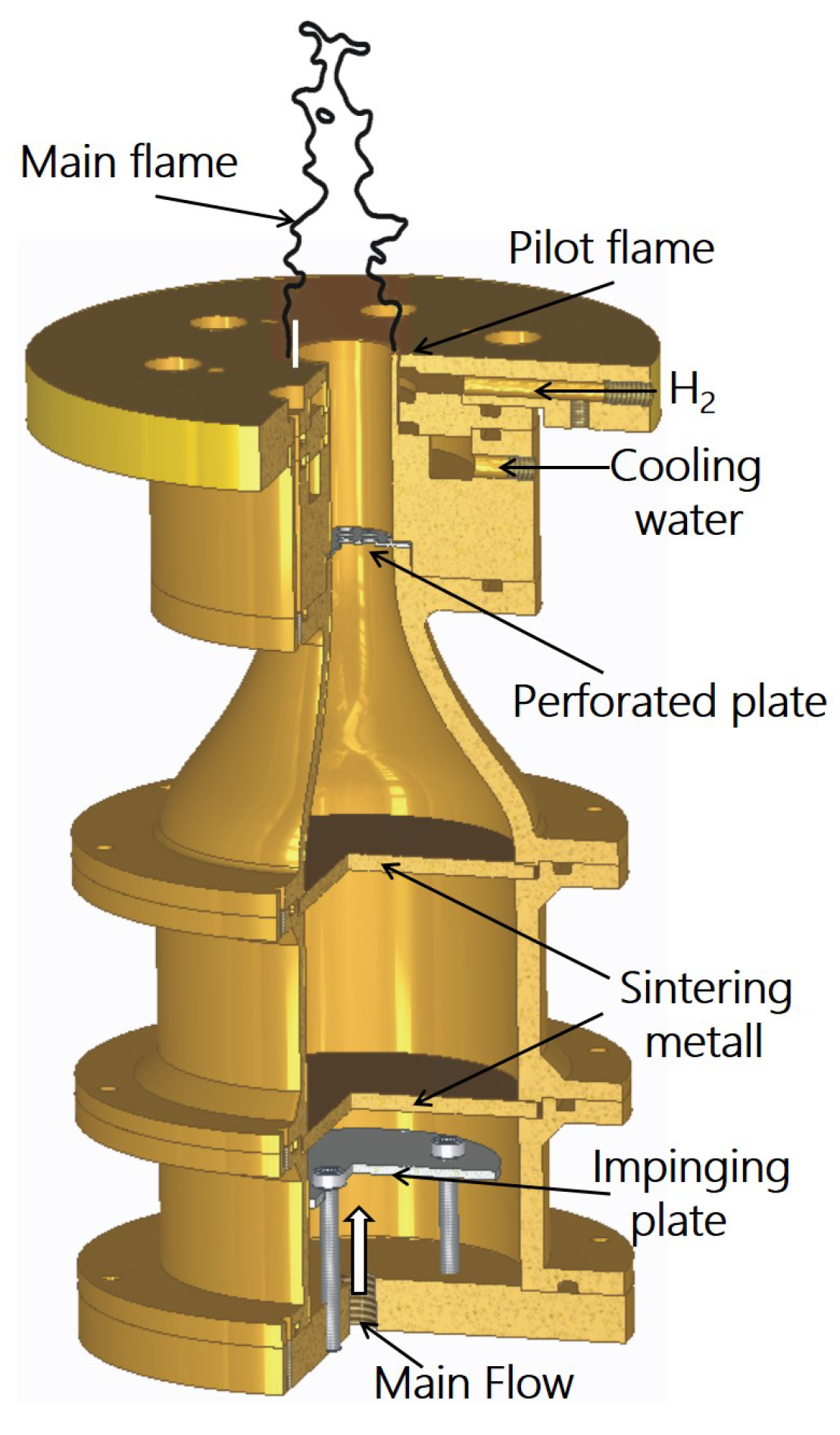
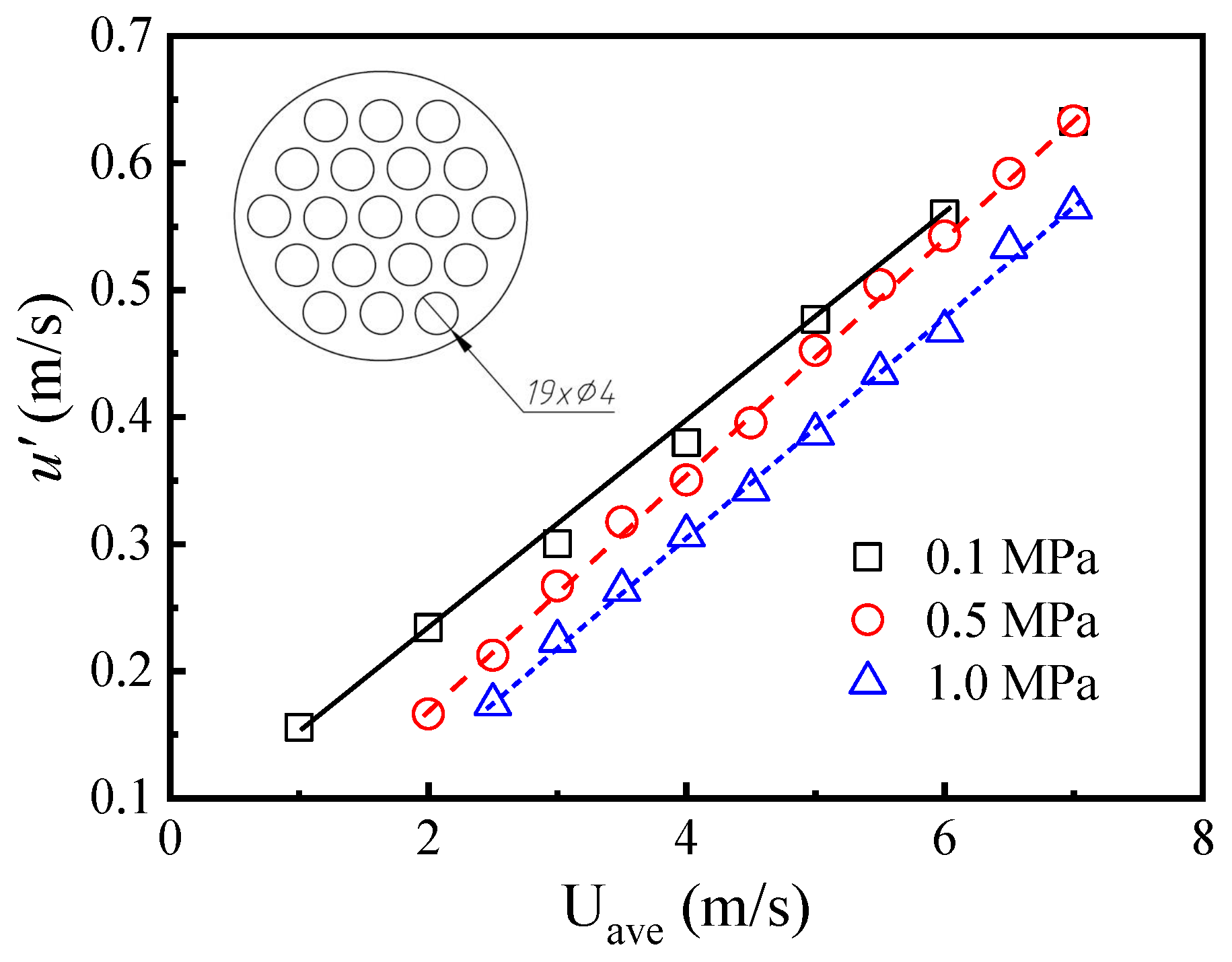

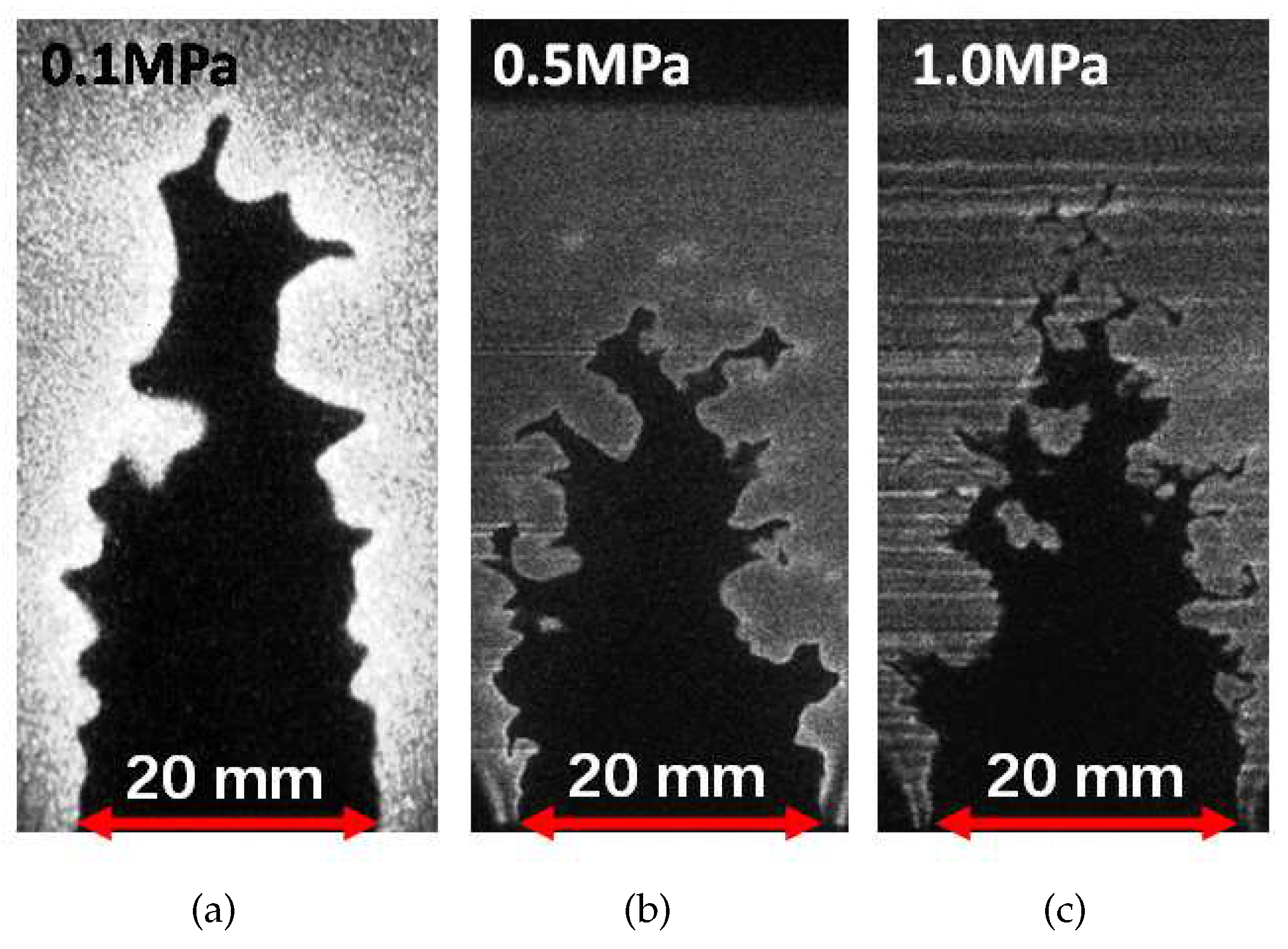

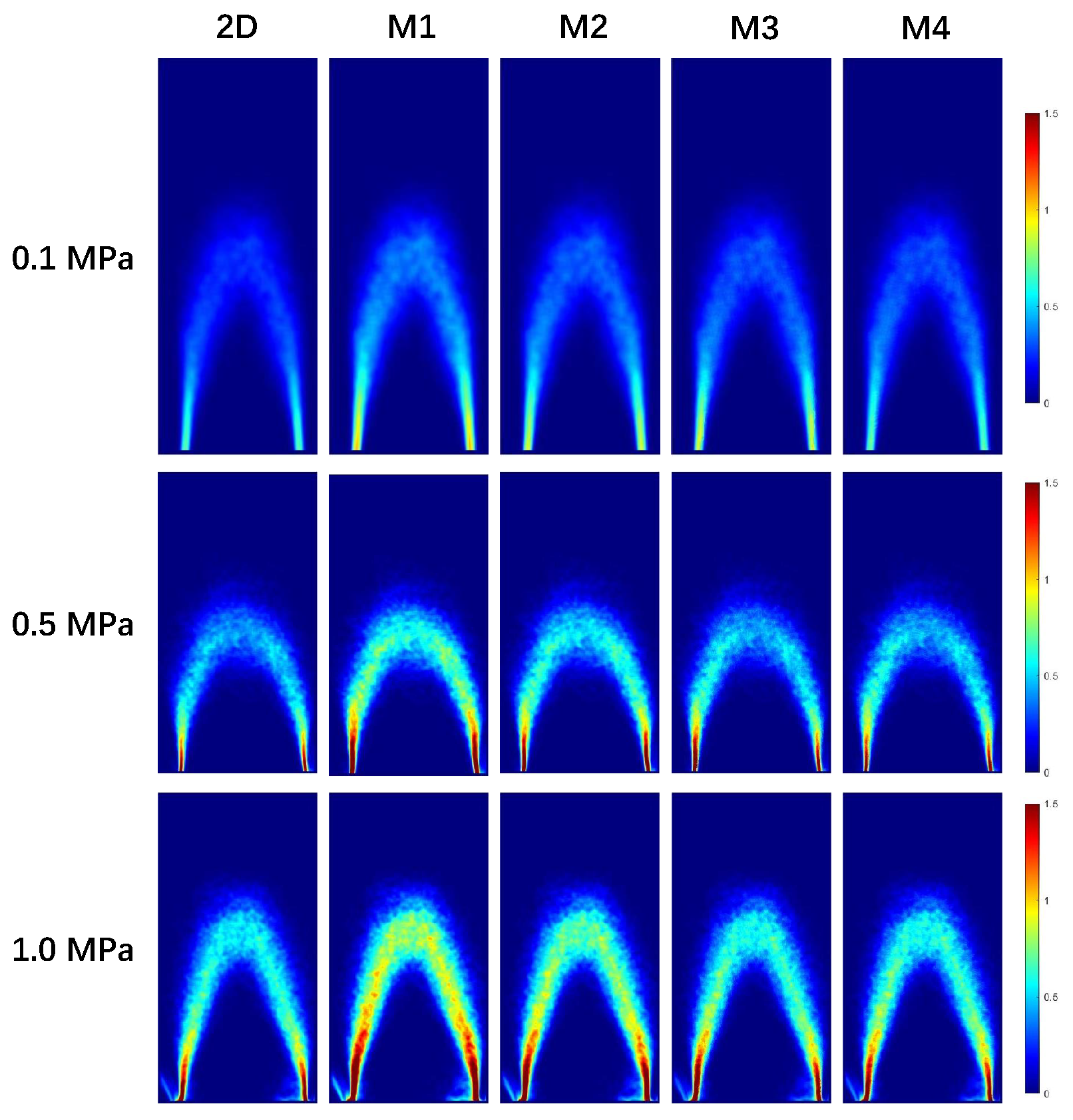
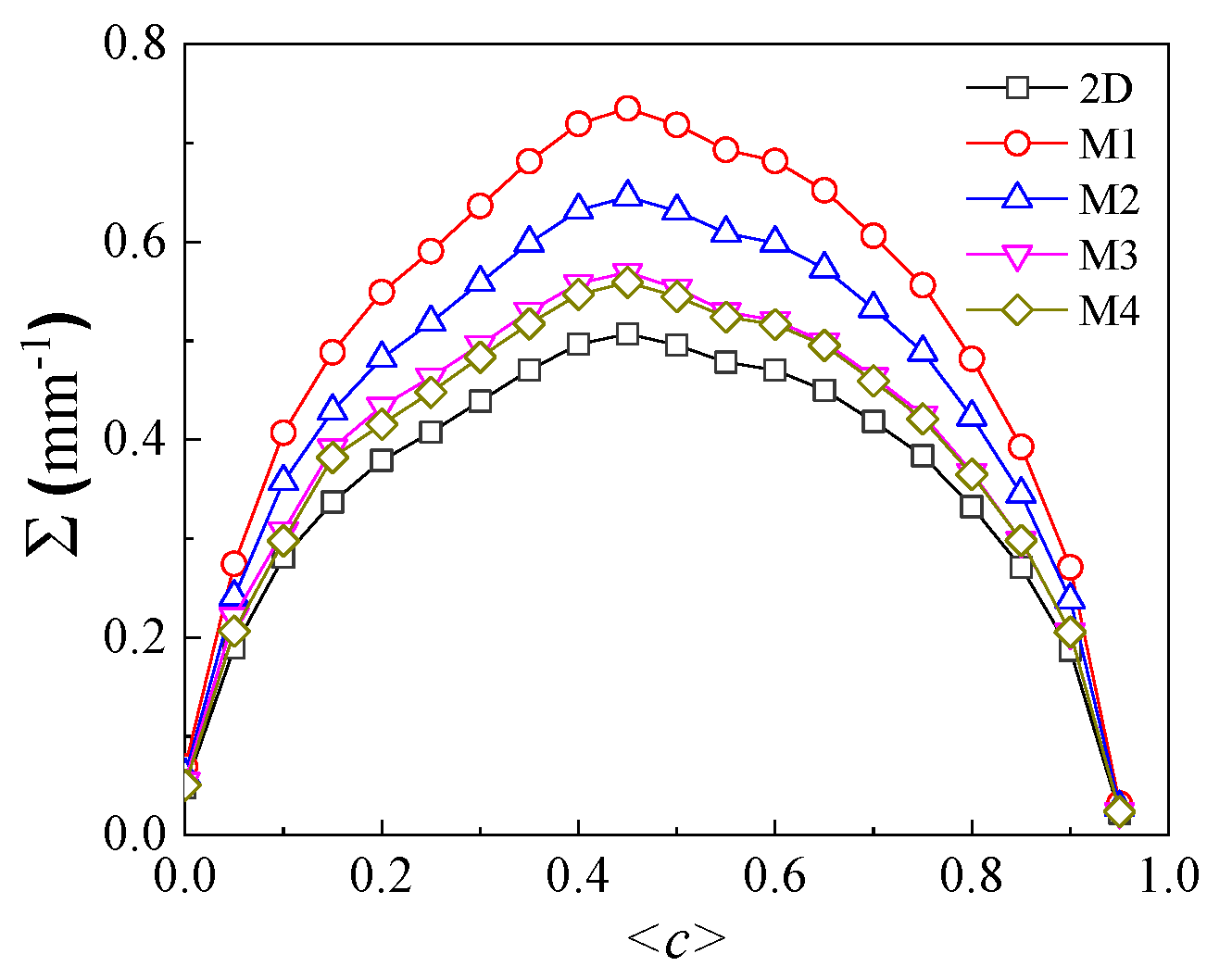

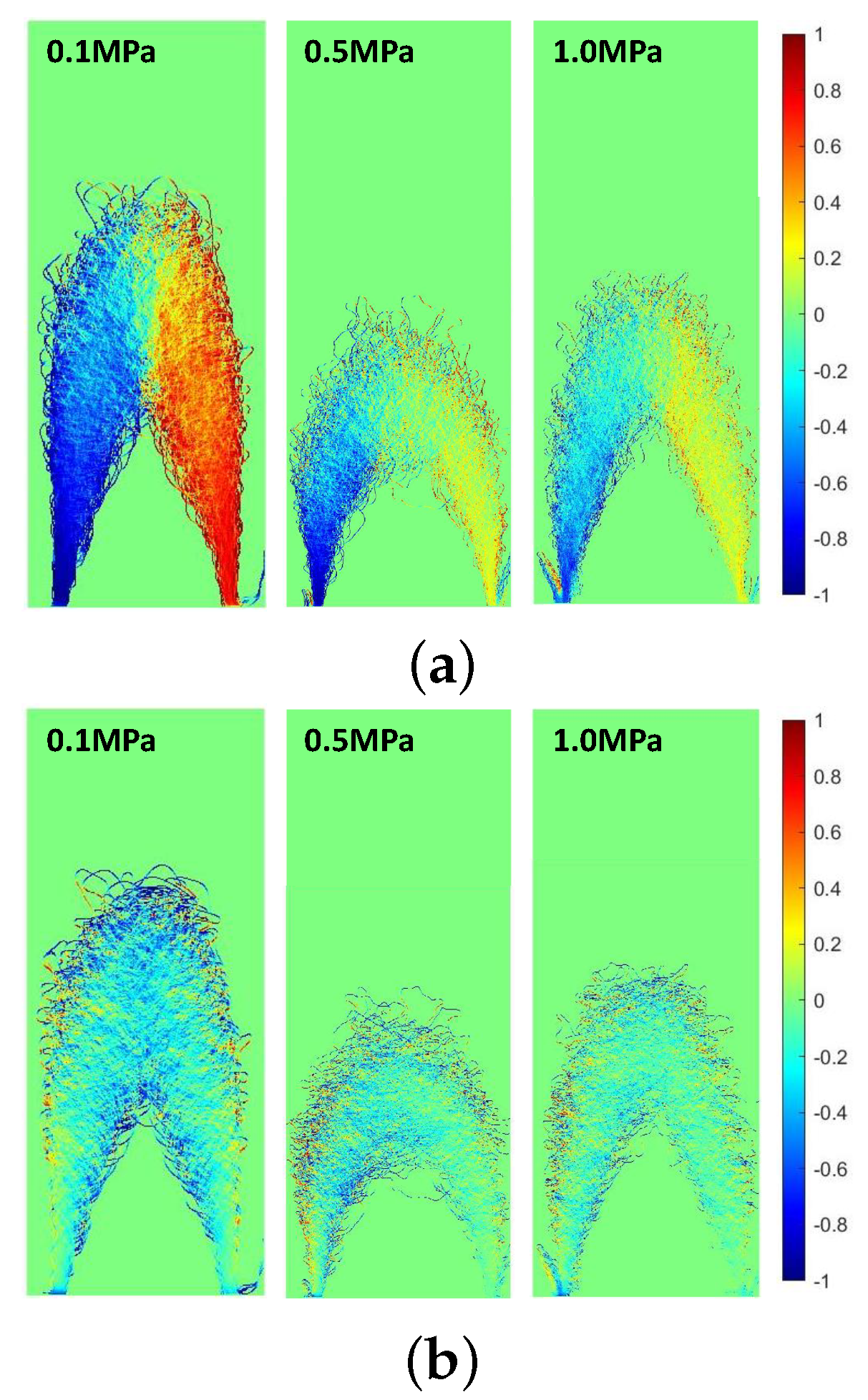
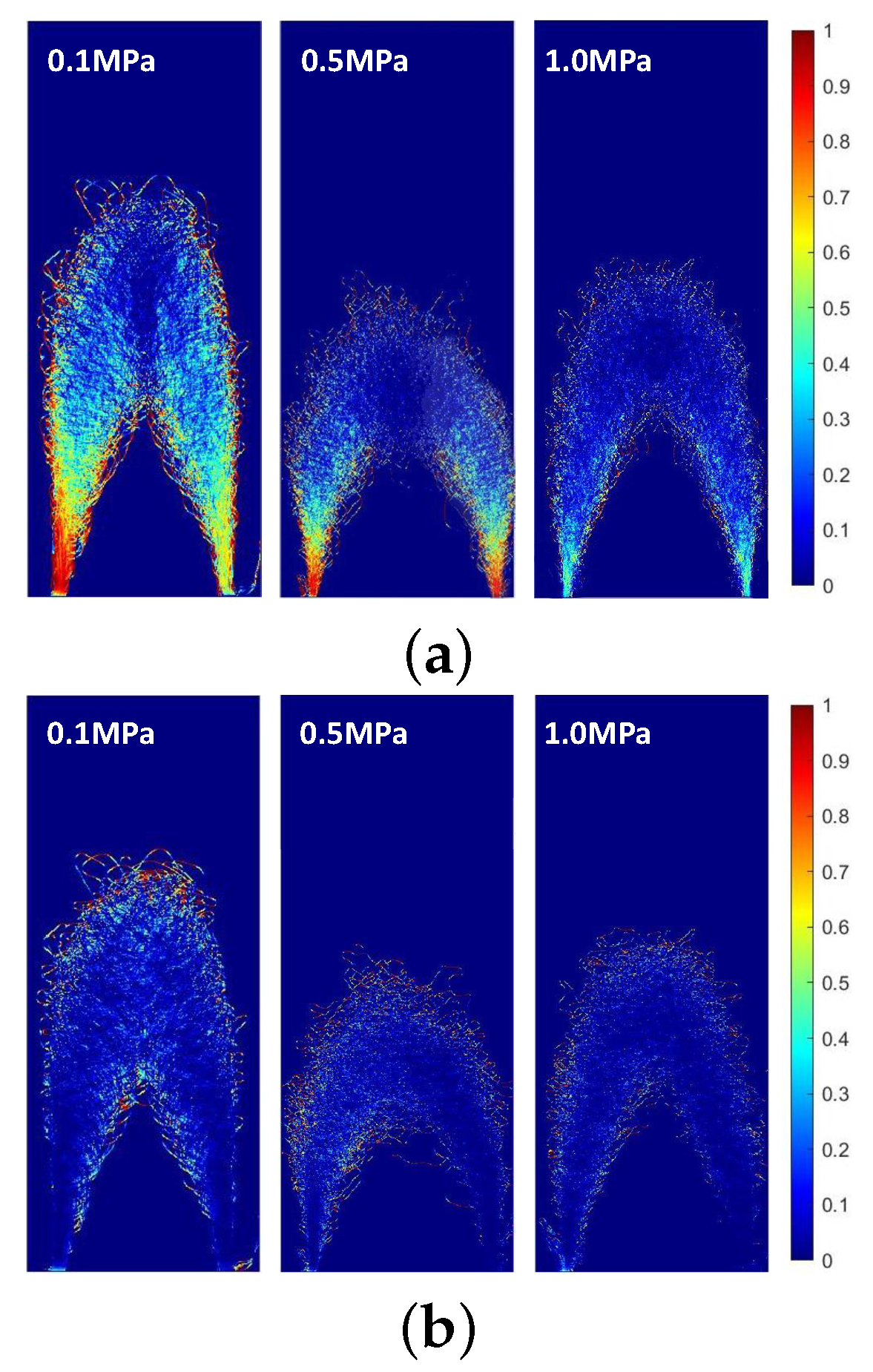
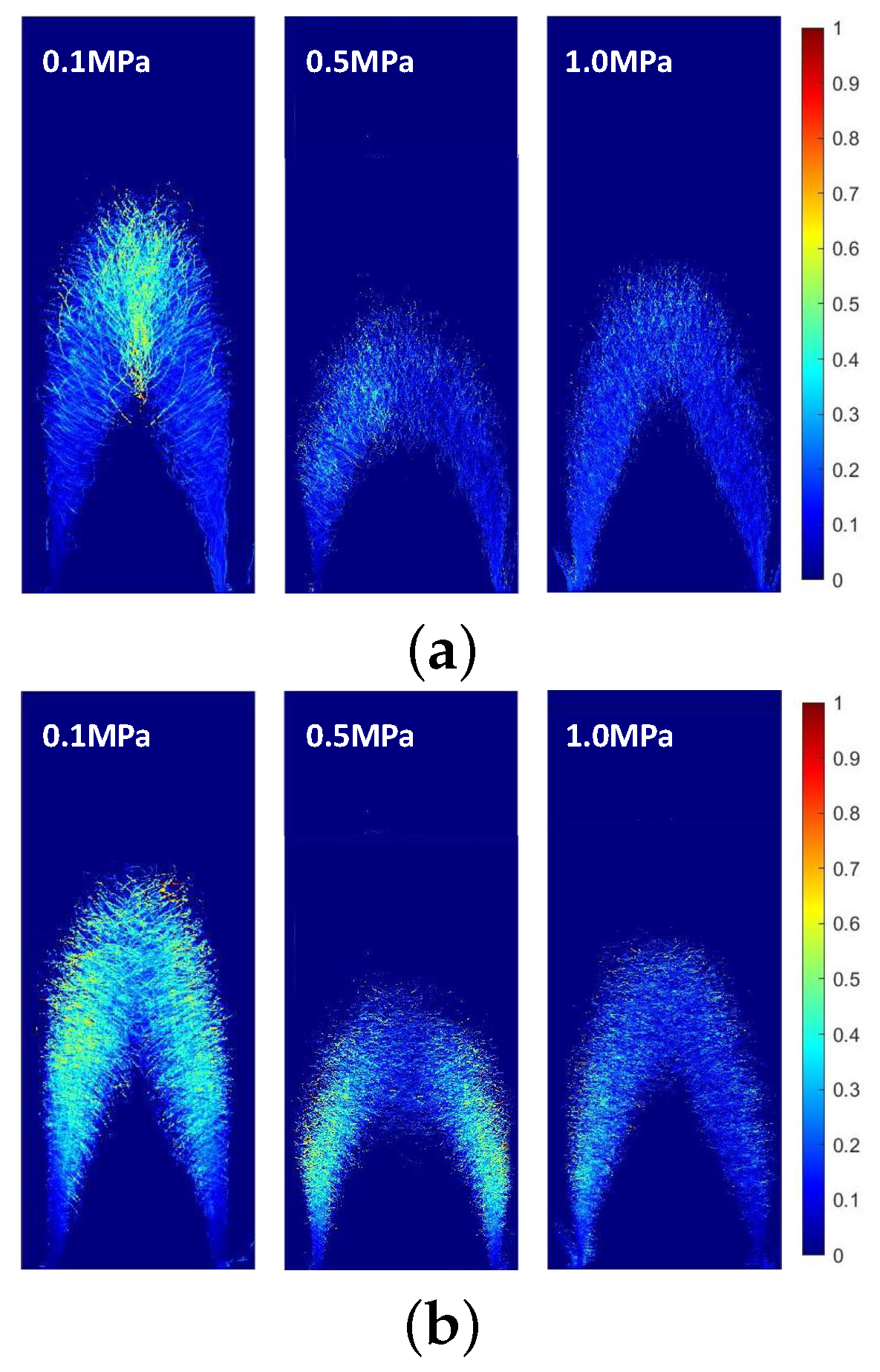
| Mixture | P (MPa) | (cm/s) | U (m/s) | |||
|---|---|---|---|---|---|---|
| /air | 0.9 | 0.1 | 30.97 | 1.12 | 2.92 | 0.000917 |
| /air | 1.0 | 0.5 | 18.78 | 5.57 | 3.0 | 0.000917 |
| /air | 1.0 | 1.0 | 14.49 | 11.14 | 3.0 | 0.000917 |
| P (MPa) | 2D | M1 | M2 | M3 | M4 |
|---|---|---|---|---|---|
| 0.1 | 0.96 | 1.40 | 1.23 | 1.19 | 1.09 |
| 0.5 | 0.52 | 0.75 | 0.66 | 0.57 | 0.56 |
| 1.0 | 0.45 | 0.65 | 0.58 | 0.51 | 0.49 |
Disclaimer/Publisher’s Note: The statements, opinions and data contained in all publications are solely those of the individual author(s) and contributor(s) and not of MDPI and/or the editor(s). MDPI and/or the editor(s) disclaim responsibility for any injury to people or property resulting from any ideas, methods, instructions or products referred to in the content. |
© 2023 by the authors. Licensee MDPI, Basel, Switzerland. This article is an open access article distributed under the terms and conditions of the Creative Commons Attribution (CC BY) license (https://creativecommons.org/licenses/by/4.0/).
Share and Cite
Zhang, M.; Wang, J.; Huang, Z. Analysis of Pressure Effect on Three-Dimensional Flame Surface Density Estimation. Appl. Sci. 2023, 13, 4691. https://doi.org/10.3390/app13084691
Zhang M, Wang J, Huang Z. Analysis of Pressure Effect on Three-Dimensional Flame Surface Density Estimation. Applied Sciences. 2023; 13(8):4691. https://doi.org/10.3390/app13084691
Chicago/Turabian StyleZhang, Meng, Jinhua Wang, and Zuohua Huang. 2023. "Analysis of Pressure Effect on Three-Dimensional Flame Surface Density Estimation" Applied Sciences 13, no. 8: 4691. https://doi.org/10.3390/app13084691
APA StyleZhang, M., Wang, J., & Huang, Z. (2023). Analysis of Pressure Effect on Three-Dimensional Flame Surface Density Estimation. Applied Sciences, 13(8), 4691. https://doi.org/10.3390/app13084691







